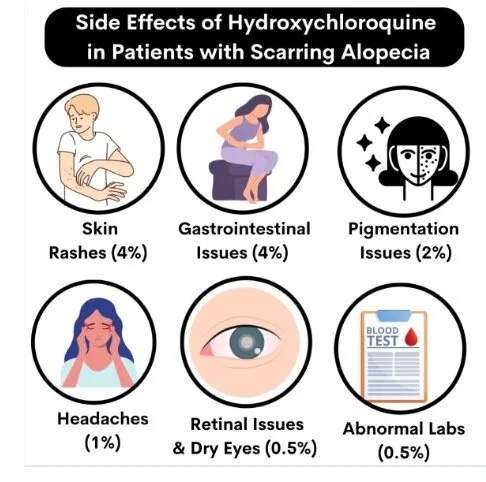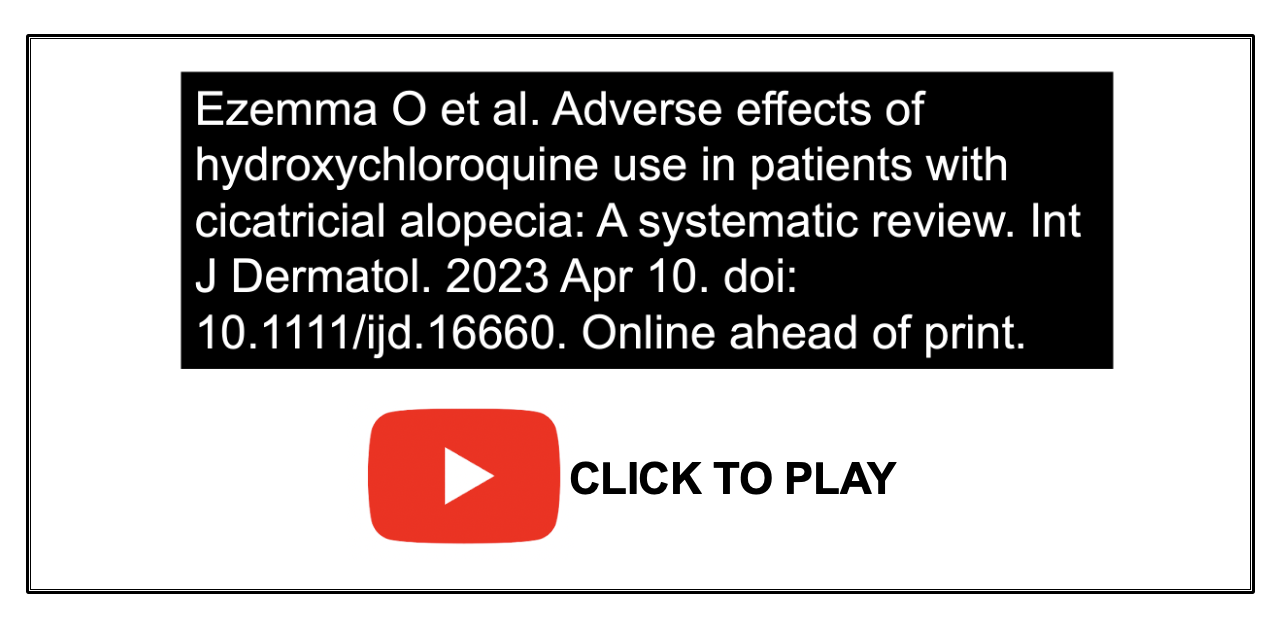What side effects do patients with scarring alopecia experience from hydroxychloroquine ?
Rashes, GI disturbance, Pigmentation Issues, Headaches and Lab Issues Top the List of Side Effects
Hydroxychloroquine is commonly used to treat several scarring alopecias including lichen planopilaris, frontal fibrosing alopecia, discoid lupus and pseudopelade. It tends to be reasonably well tolerated although side effects can occur.
Ezemma O et al. 2023
Authors of a new study set out to perform a systematic review of all published studies relating to hydroxychloroquine side effects in patients with scarring alopecia. Studies unrelated to scarring alopecia and studies not investigating HCQ use and/or side effects were excluded.
There were 10 studies that met the authors inclusion criteria including eight retrospective chart reviews, one randomized control trial and one case series. A total of 389 patients were reviewed. The average age of patients was 56.1 years and 83% of patients with gender information identified as female. Eighty-one percent of patients had LPP, FFA, or combination LPP/FFA. HCQ dose ranged from 100 to 500 mg daily.
Interestingly 88 % of patients in these 10 studies reported no adverse events from treatment with hydroxychloroquine.
The most common side effects were adverse skin reactions (16/389, 4.1%), gastrointestinal problems (14/389, 3.6%), skin hyperpigmentation (7/389, 1.8%), and headaches (5/389, 1.2%). Visual changes and retinal toxicity occurred in 0.5% (2/389) of patients. Laboratory abnormalities, dyspnea, dry eyes, and cardiovascular side effects were reported in 0.2% (1/389) of patients.
Of note, two patients who developed retinal toxicity were dose above American Academy of Ophthalmology’s (AAO) recommended dose of 5 mg/kg/day or less.
One patient developed non-sustained ventricular tachycardia 17 months after starting HCQ 400 mg daily. However, this patient had many heart problems before starting the drug which made is possible that the heart rhythm problem was due to her pre-existing heart disease rather than the hydroxychloroquine itself.
Conclusion
This study reminds us that most patients do really well on hydroxychloroquine. In fact, 88% of patients (at least in this study) don’t really seem to report side effects at all.
The top 4 side effects are rashes, GI disturbances, pigmentation issues and headaches. For most patients, lab abnormalities would probably be the fifth place side effect.
It’s important to know about these side effects so that we can counsel patients on potential side effects.
Keeping Hydroxychloroquine As Safe as Possible: My Top 10 Tips
There are several tips to help keep hydroxychloroquine as safe as possible.
1. Keep the dose under 5 mg per kg. One is not obligated to use maximal doses of hydroxychloroquine. However, for many many patients one needs to be aware that the dose is often well under 400 mg daily. We need to get out of the habit of assuming that the dose for all patients is 400 mg daily.
2. Ensure baseline labs and eye examinations are done. Labs need to be repeated after starting to catch the rare event that liver enzymes bump up after starting the drug …. or blood counts drop. This is pretty rare. Eye examinations are needed after starting hydroxychloroquine too. For someone patients with no risk factors, the second visit to the eye doctor might be at year 5. For others with moderate risk factors, the second examination might be sooner.
3. Constantly review how long patients are on hydroxychloroquine. Keep track of the duration. The chances of side effects increase the longer and longer one is using the medication. If it’s clear that the medication is needed, keep using it. If it’s not needed, then stop it or reduce the dose. A few years is not typically a problem. After 4, 6 and 8 years one needs to ask “Is this medication really needed?”
4. Be careful about using hydroxychloroquine in patients over 65 and especially over 75 years of age. Patients over 75 years of age, in my experience, are more sensitive to the medication. Use as low of a dose as possible.
5. Be careful about using the medication is there is any pre-existing liver or kidney disease. The chances of toxicity increases. Get an opinion from a liver or kidney specialist if there is serious dysfunction.
6. Don’t use the medication in patients who use certain medications such as tamoxifen (increases chance of retinal toxicity) or patients who use drugs that prolong the QT interval (increases the chance of heart rhythm problems). One must be careful with any of the medications in the table below>
7. Be careful about using the medication is there is any pre-existing significant heart disease. A baseline ECG will be helpful as well as a follow up ECG. Get a consultation from a cardiologist if any doubt exists.
8. If there is pre-existing retinal disease of any kind, don’t use it unless an ophthalmologist have given the okay.
9. Monitor for pigmentation. Pigmentation is not common but when it occurs it may be a good idea to consider stopping the medication. Improvements (at least to some degree) can occur if medications are stopped early in the course of pigmentation. Complete clearance does not typically happen – so the sooner one stops the better. Patients do not always realize this is happening so one need to monitor for this side effect.
10. Limit use of the medication in patients with electrolyte abnormalities, including issues with potassium, calcium and magnesium, namely hypokalemia, hypocalcemia and hypomagnesemia. Unstable lab tests are a sign that it’s probably not worth prescribing this medication.
REFERENCES
Ezemma O et al. Adverse effects of hydroxychloroquine use in patients with cicatricial alopecia: A systematic review. Int J Dermatol. 2023 Apr 10. doi: 10.1111/ijd.16660. Online ahead of print.
This article was written by Dr. Jeff Donovan, a Canadian and US board certified dermatologist specializing exclusively in hair loss.


